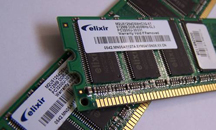From:TheBahamasWeekly.com
Upgrading Your Computer’s Memory
By Kristofferson Culmer
May 19, 2008 - 12:43:00 PM
In my last article I wrote about simple things you can do to improve your computer’s speed and performance. But, what happens if you do all of those things and you still aren’t satisfied with your computer’s speed? Well…that usually means you need more memory. Now, don’t get confused. When most people hear that they need more memory what’s the first thing they do? They usually go to my computer -> C:/ drive -> right click and check to see how much memory they have available on their hard drive; it’s usually a lot, but that’s not the type of memory you need, though.
Memory in you hard drive is Read Only Memory (ROM), and that’s where your computer stores all of its programs and software. The type of memory you need is Random Access Memory (RAM), which where your computer stores the information it uses frequently when it’s running an application(s). The more programs you run, the more RAM space you occupy, the slower your computer will operate because it doesn’t have the necessary free space to process more information. Most people think they need to have a computer technician perform a memory upgrade, but that is not the case. Upgrading computer memory is something anybody can do, and I will tell you how to do just that.
What you'll need:
-
Compatible RAM (consult computer manual)
-
Phillips screwdriver
-
Your computer
-
Right click "My Computer", select "properties", Under "Computer," your expanded RAM size should be listed. Write that number down.

Step 1: Prepare your computer

Shut down your computer as usual and turn off the switch on the back of the power supply unit located at the back of your computer. After turning off the power supply, wait at least 10 seconds before opening the computer case to allow the motherboard's capacitors to discharge.

While working inside your case, be mindful of static electricity. To avoid building up a static charge that could potentially short out a component, remember to touch a grounded metal surface from time to time to discharge any static charge you have built up.
Step 2: Find and prepare an empty RAM socket

This is easy enough. Just locate the RAM sockets on your motherboard and find an empty one. If you've never installed RAM in your computer, you should have at least one or two empty slots. When you're choosing the socket in which to install your RAM, again you should consult your manual. For example, your motherboard may require you to fill the sockets in a particular order.

Next, the RAM retaining clips need to be opened up in order for RAM to be installed. All you need to do is press the retaining clips outward, opening the socket for installation
.
Step 3: Install your RAM
Now pick up your stick of RAM by the edges - it s best not to get your fingerprints all over the working parts of the memory itself. The RAM should be slotted so that it can fit in the socket only one way, so just line up the slotted RAM with your motherboard's RAM socket.
Firmly press the RAM until it is seated securely in the socket. If your socket has retaining clips, press down until the clips snap back into place.

After this, your RAM should be properly seated and installed.
Step 4: Finishing up
It's all pretty simple from here on out. Replace your computer's side panel and screw it into place. Plug in your power supply unit (remembering to flip the switch back on) and boot up.
 To verify that your RAM upgrade was successful, right-click on My Computer and select Properties. Under "Computer," your expanded RAM size should be listed. If everything went well, you should see more MBs of RAM than you had before your installation (compare this number with the one you wrote down earlier).
To verify that your RAM upgrade was successful, right-click on My Computer and select Properties. Under "Computer," your expanded RAM size should be listed. If everything went well, you should see more MBs of RAM than you had before your installation (compare this number with the one you wrote down earlier).
Easy, right? Your newfound ability to install RAM should help out with those long load times and major system slow-downs you've been putting up with lately.
About the Author:
Kristofferson Culmer was born in
Nassau but grew up in
Freeport for practically all of his life. He is a Magna Cum Laude graduate of
Central
Methodist
University, holding Bachelor’s of Science Degrees in Computer Science and Business, and is currently pursuing a Masters of Science Degree in Computer Science. He has recently ventured out into the business world, starting his own business: Creative Web Solutions, specializing in web development, corporate branding, and marketing. Kristofferson enjoys working out and being active, meeting people, learning, and enjoying the simple things in life. Kristofferson can be contacted at
kculmer@centralmethodist.edu
.
© Copyright 2008 by thebahamasweekly.com -







 To verify that your RAM upgrade was successful, right-click on My Computer and select Properties. Under "Computer," your expanded RAM size should be listed. If everything went well, you should see more MBs of RAM than you had before your installation (compare this number with the one you wrote down earlier).
To verify that your RAM upgrade was successful, right-click on My Computer and select Properties. Under "Computer," your expanded RAM size should be listed. If everything went well, you should see more MBs of RAM than you had before your installation (compare this number with the one you wrote down earlier).